
| Post Info | TOPIC: Tings you'll need for tank startup | ||||||
|---|---|---|---|---|---|---|---|
|
|
|
||||||
|
|||||||
|
|
||



|

| Post Info | TOPIC: Tings you'll need for tank startup | ||||||
|---|---|---|---|---|---|---|---|
|
|
|
||||||
|
|||||||
|
|
||



|